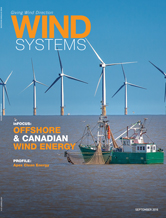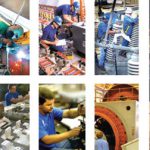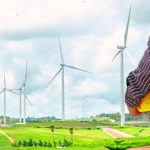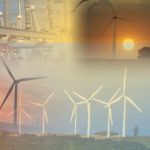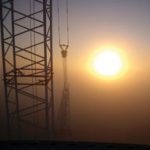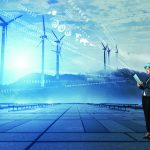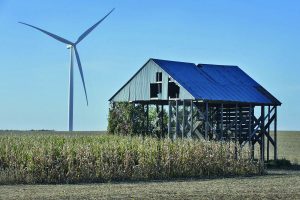Race-car drivers say the point of acceleration begins at the apex of a curve. This is how Apex Clean Energy chose its name — a name consistent with its mission to accelerate the shift to clean energy.
Although Apex was officially founded in 2009, its roots go much deeper.
“I like to say it’s the next generation of a company called Greenlight Energy,” said Steve Vavrik, chief commercial officer for Apex. “Greenlight was founded in 2000 by our CEO, Sandy Reisky, as an independent wind-energy company that would go on to develop $750 million of facilities with a combined generating capacity of 450 MW.”
Greenlight was acquired by BP Alternative Energy in 2006. That set the stage for Reisky and the leadership team to launch several new clean-energy companies including solar, waste-to-energy, and direct-drive wave energy, followed by Apex in 2009. Further fueling Apex was capital from the sale of solar-focused Axio Power to SunEdison in 2011.
“They are all related through the consistent vision and the continued commitment of the core group of investors who helped launch Greenlight more than 15 years ago,” Vavrik said.
 The Power of the Pipeline
The Power of the Pipeline
Many of the executives responsible for guiding Greenlight remained on the team when Apex was founded.
The key to its evolution as a market leader — Apex brought more wind power online than any other company in 2015 — is a guiding principle to invest in a diverse portfolio of high-quality energy resources. As such, Apex has built the largest pipeline of active wind-energy projects of any company in the U.S., spanning 25 states and representing more than 12 GW of potential.
“We’re not focused on any one region, we have established a position in each of the major markets,” Vavrik said.
As Apex has grown, it has successfully attracted a team of more than 250 professionals with expertise in wind power going back 10 to 15 years — including Vavrik, who said he’s been in the power industry since 1996.
So even though Apex is not as established as the larger utility players, the leaders have been at it for a long time, helping explain its fast-evolving track record in developing, financing, and delivering large-scale, clean-energy solutions.
Along the way, Apex has installed wind turbines from top suppliers including Acciona, GE, Mitsubishi, REPower, Siemens, and Vestas to translate the potential of the wind to power on the grid.
Sinking Costs, Rising Demand
There have been many changes in the world of power in the past decade or so.
First and foremost, the cost of generating wind energy has fallen 66 percent since 2010 according to the American Wind Energy Association (AWEA). The second major shift is the emergence of a whole new group of customers. In addition to utilities looking to diversify their generation mix and replace retiring coal and nuclear plants, corporations are purchasing clean power directly from developers.
“What is new is the interest from a broad range of Fortune 500 companies looking to enter power purchase agreements, especially technology and retail companies,” Vavrik said. “Like any commodity input, electricity prices are a risk that needs to be managed. Failure to do so can directly affect financial performance, especially for those companies operating data centers such as Amazon, Facebook, and Microsoft, where power supply is a significant operating cost.”
The stable price of wind energy over a long-term contract is an effective hedge against long-term exposure to energy inflation that also can mitigate the risk of future carbon pricing. Of course, clean energy also addresses the environmental, social, and governance considerations in the boardroom.
“So the success of clean energy begins with a cost-competitive product with significant hedging advantages, that also addresses mission-driven motivations, where clean energy procurement becomes part of their corporate identity and responsibility to their shareholders and customers,” Vavrik said.
Customized Solutions
The flexibility provided by the Apex pipeline of projects allows companies to optimize their purchase of renewable energy. One such factor is location, as a company may want the power generated near its headquarters or key facilities. At the same time, when a company begins exploring renewable energy procurement, an education process takes place illuminating opportunities to achieve goals that might not be obvious at first.
As an example, Vavrik brings up Steelcase — a forward-thinking furniture manufacturer based in Michigan.
While Michigan has the potential for wind, at the time an appropriate project did not exist in the state to meet the company’s need.
So Apex introduced Steelcase to a project in Oklahoma.
Power doesn’t actually flow from Oklahoma to Michigan, but Vavrik called investing in such a project having a “bucket effect.”
“Imagine the electricity we all use fills a bucket the size of the U.S. A new wind facility fills the bucket in Oklahoma, and Steelcase is utilizing power in Michigan. Overall, the water in the bucket is getting cleaner. Steelcase was able to introduce new renewable power onto the grid, while managing their energy risk, comprehensively meeting their objectives,” he said.
Similarly, a company such as IKEA has operations spanning the globe and an objective to make the grid greener through the addition of renewable energy.
“The starting principle for IKEA was focusing on their overall global carbon footprint,” Vavrik said. “They had established a clean-energy track record with on-site solar and other investments in eight wind facilities outside of the U.S. They sought out Apex to add large-scale U.S. facilities to their portfolio. Working together with Apex, IKEA is on-track to achieving its goals.”
In addition to IKEA and Steelcase, Apex has worked with utilities and infrastructure investors including AEP, Southern Power, Google, and First Reserve.
At the end of the day, Vavrik said Apex is delivering value to both utility and corporate purchasers by leveraging a comprehensive suite of services from development to finance to operating and managing the generation facilities over the long-term.
“We want to come up with the power sales agreement that fits precise needs,” he said. “So we take a partnership approach.”
The Role of Asset Management
In most cases, Apex operates and maintains the wind facilities it builds for its owners, delivering comprehensive asset management services over the life of the project.
Apex recently opened a Remote Operations Control Center, which is manned 24 hours a day, 365 days a year.
“The real-time application of complex technology to assess and control the turbines and the flow of power is impressive,” Vavrik said. “But it’s the quality of our people that make the difference, both in Charlottesville and the teams out on our sites.”
As communities take a greater interest in the operation and long-term stewardship of wind farms, the facility managers become critical ambassadors for the project owners. Not only do they perform inspections, maintenance, and data collection, but they also are the primary contact for EMS crews, elected leaders, and environmental stakeholders.
“We aim to be good neighbors; our staff lives down the road from the sites where they work, in the communities hosting our facilities,” Vavrik said. “We originated the sites, develop and build them, and the relationship continues through operations.”
Batter Up
Getting a wind farm built and operating doesn’t really take that long — six to nine months on average, but the steps to get to that point can take years of planning and development.
Vavrik compares it to a baseball game.
The first and second innings are all about securing the land. Apex approaches landowners, conducts deep habitat and environmental studies, and builds a land position that captures the wind and extends to the point of transmission interconnection with the grid.
“We’re talking about everything from generating income to preserving multigenerational land to tracking multi-season migration patterns of any number of species,” Vavrik said.
The third and fourth innings are all about wind data. Beginning with construction of meteorological towers and data comparison with existing weather stations, specific turbine placement is planned.
“The trick is having a long-term data set, and extrapolating the data to the hub height of 80 meters, or 110 meters,” Vavrik said. “So that’s the art-and-science part where multiple years of data establish the confidence to make a multi-year forecast of the wind resource across seasons.”
The middle innings are consumed with projecting the performance of the future facility, gaining interconnection rights, permitting at the local and state level, and identification of customers for the power. The closers are the finance team, who stitch together the capital partners to get the deal done.
“It’s a process that can take two to five years, and the community is going to evolve as well,” Vavrik said. “That’s a critical element here, working to provide information and opportunities for engagement with the local community.”
Accelerating the Shift to Clean Energy
Apex has the capability of offering utilities and companies many options on their path to procuring clean energy. It’s a model built on the resource, and bringing the resource to market in ways that dramatically expand the clean-energy footprint across the country.
Wind was America’s largest source of new electricity last year, representing more than 40 percent of capacity additions, and it is expected to quadruple by 2030 to supply 20 percent of the nation’s electricity.
With wind farms completed in Illinois, Texas, and Oklahoma, and more than 70 wind and solar projects in various phases of development, Apex is poised to accelerate the shift to clean energy.
“I would say everyone here believes renewable energy should become more and more part of our mix if not the entire mix,” Vavrik said. “It’s inevitable just given the fundamentals of the technology, but we want it to happen faster. So that’s what keeps us going.”



















